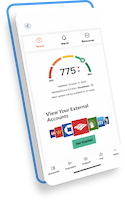Credit cards, student loans, car payments — most of us walk through our lives carrying some amount of debt, and sometimes, quite a lot of it. Per Experian’s 2020 State of Credit report, the average American carries more than $25,000 in debt, not including mortgages. While hard to avoid, those debts can serve as anchors, making it difficult to achieve loftier financial goals.
When you apply for a mortgage, your lender will collect information about your credit history and financial status to determine whether or not you qualify for a loan — and if so, what your interest rate and other loan parameters will be. One of the calculations they’ll perform as part of this assessment? Your DTI, or debt-to-income ratio, which is a key metric in determining your eligibility for mortgages and other loans.
While a high DTI can make it harder to qualify, it doesn’t mean a mortgage is out of reach. Here’s a breakdown of how debt-to-income ratios can affect mortgage eligibility, and options for mortgage seekers with higher DTIs to consider.
What does DTI stand for?
DTI stands for debt-to-income ratio, which — as its name suggests — is a figure, expressed as a percentage, that compares the amount of money you owe each month with the amount of money you’re earning.
A lower debt-to-income ratio means less debt and more income, while a higher debt-to-income ratio means the opposite. Either way, the information is important to mortgage lenders, who use it to estimate how much more debt you can afford. Higher DTI applicants are considered riskier borrowers, since their monthly budgets are already stretched pretty thin by existing bills.
How is DTI calculated?
When calculating the DTI, Quontic factors in the proposed mortgage payment of the new loan. Broadly speaking, DTI is calculated by adding up all your monthly debt payments and dividing them by your gross monthly income. That’s the amount of money you make before taxes are taken out.
In other words for you mathy folks:
Total required monthly debt payments
Gross monthly income
=
DTI
However, it’s important to note that only minimum monthly payments need to be fed into the calculation, even if you typically pay more than the minimum (gold star for you!). Additionally, only debt is counted, so other recurring monthly bills, like utilities or health insurance premiums, won’t factor into the equation.
Here are some debts that are usually factored in when calculating a debt-to-income ratio:
- Existing mortgage payment(s), or rent
- Auto loan payments
- Credit card payments
- Student loan payments
- Child support or alimony payments
- Personal loan payments
And here are some recurring monthly payments that are not considered when calculating debt-to-income:
- Utilities
- Health insurance premiums
- Retirement contributions
- Other monthly spending, including food and transportation costs
Here’s an example:
Say you earn $60,000 before taxes, which comes to $5,000 per month. Your monthly debts include $1000 for rent, a $400 car payment, a $250 student loan payment, and three credit cards you’re paying off with $35 minimums each.
So:
$1000 + $400 + $250 + $35 + $35 + $35 = $1,755
$1,755/$5,000 = 0.351, or 35%, which is your DTI!
Use Quontic’s free DTI calculator to get an idea of what your Debt-to-Income ratio is.
What is the difference between front-end and back-end DTI?
You’ll sometimes see a lender express maximum DTI ratios in pairs, such as 29%/41%. This is because they’re expressing two separate figures: front-end DTI and back-end DTI.
Front-end DTI is calculated using only housing-related debts and expenses, such as your mortgage, property taxes, and homeowners insurance.
Back-end DTI is calculated using all of your monthly debt repayments, including housing and the others listed above, and is also the number most often used by lenders to assess your eligibility. For the purposes of this article, all the specific debt-to-income ratios we’ll mention are back-end DTI.
Why does DTI matter?
As mentioned above, DTI is one of the factors mortgage lenders look at when deciding whether or not a borrower is eligible for a loan. DTI gives lenders a pretty clear picture of exactly how much additional debt a borrower’s budget has room for.
Debt-to-income can be a frustrating metric for would-be homebuyers — especially young ones still getting financially established — as it can preclude even those with high incomes and good credit histories from getting approved for mortgage loans.
However, DTI is only one measure lenders use to qualify borrowers, and certain programs do offer mortgages to borrowers with higher debt-to-income ratios.
What is the debt-to-income ratio to qualify for a mortgage?
The specific DTI required to qualify for a mortgage depends on the mortgage lender, as well as other financial markers like down payment amount and credit score.
For instance, Fannie Mae, which sets the standards for conventional loans, sets a maximum DTI of 36%, though it can go up to 45% for those with higher down payments and/or better credit scores.
Government-subsidized loans, on the other hand, such as FHA, USDA and VA loans, generally offer more lenient DTI maximums. For USDA loans, the maximum DTI is 41%; for FHA loans, it’s 43% (though sometimes it can go as high as 56.9% with certain compensating factors), and VA loans don’t carry a specific maximum DTI, but requires additional financial scrutiny for those whose ratio is above 41%.
Can I get approved for a mortgage with a high debt-to-income ratio?
It depends how high and what specific mortgage program you’re looking for — but yes, there are ways to qualify for a loan with a higher debt-to-income ratio!
Choosing a government-subsidized loan like the ones mentioned above can increase the maximum DTI ceiling, opening the possibility of homeownership to those who have higher debt levels. Additionally, with non-traditional mortgages, like Quontic’s Non-Traditional Loan*, the debt-to-income ratio may be less than what a traditional lender might calculate because our Non-Traditional Loan programs use alternative documentation to qualify borrowers. These types of mortgages are also helpful for non-traditional earners, such as those who are self-employed.
How can I lower my debt-to-income ratio?
If you do need to lower your debt-to-income ratio in order to qualify for a mortgage loan, there are many ways to do so!
The most obvious answer is to work on paying down your debts, but approaching this project strategically can help you lower your debt-to-income ratio faster. Our debt related calculators may help you develop a plan.
Because every lender’s parameters are different, it’s best to talk to your lender specifically to see what they require from their borrowers and how you might be able to shift your finances around to meet their eligibility needs. For instance, a lender might be willing to drop an installment loan from your ratio calculation if you can pay it down sufficiently up-front, even if there are some payments left. A lender may also be able to give you specific advice about which debts to focus on first.
Quontic is one of only 3% of U.S. banks bearing a CDFI certification. That shows we’re committed to providing financial services to underserved communities — and one of the most important ways we do so is by offering a wide range of mortgage loans, including Non-Traditional Loans that require little income verification to qualify.*
Additionally, we offer interest-bearing checking and savings accounts that can help you put your money to work. After all, you already work hard enough.
Have questions? We’ve got answers — and a dedicated team of professionals ready to help match you up with the mortgage of your dreams.
*All lending products are subject to approval. Rates, program terms & conditions are subject to change without notice. Not all products are available in all states or for all amounts. This does not represent an offer to enter into a loan agreement. Other requirements, restrictions & limitations apply. Information is accurate as of April 13, 2022.









